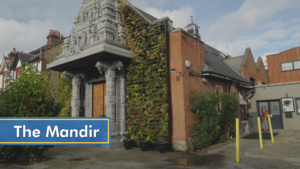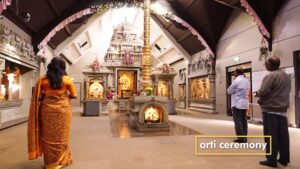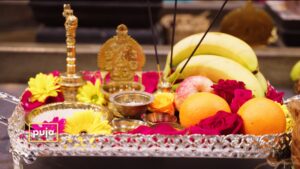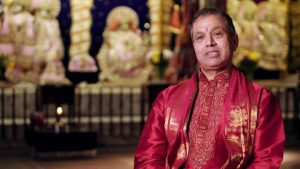Join us for Diwali (or Deepavali) for The Festival of Lights. Come inside a vibrant Mandir, where Hindus of all ages come together to celebrate one of the most cherished festivals in Hindu culture. Feel the spirit of Diwali, following families, children, and elders as they prepare offerings, light diyas, and share moments of reflection. People share what Diwali means to them, weaving a tapestry of personal meanings and traditions that reflect resilience, unity, and the victory of light over darkness.
The ancient story of the Ramayana is depicted with colourful illustrations, bringing to life the journey of Rama, his loyal brother Lakshmana, and devoted wife Sita. Together, they embark on a journey marked by courage, loyalty, and the ultimate triumph over the demon king Ravana. The visuals depict their trials and victories, culminating in the joyous return to Ayodhya and the lighting of countless lamps to celebrate good’s triumph over evil.
Through these interwoven narratives Diwali offers a heartfelt exploration of cultural identity, tradition, and spirituality, reminding viewers of the universal themes of hope and resilience celebrated during the festival Diwali.
Transcript
Diwali
Every autumn, Hindus like me celebrate the festival of Diwali or Deepavali, which means “row of lights”. It happens on the days surrounding the night of the new moon that marks the end of the Indian month Ashwin and the beginning of Kartik, which is also our New Year. It usually falls somewhere in October or November. We prepare for Diwali by cleaning and decorating our homes and the Mandir, and we buy new clothes to wear, and presents for our friends and family.
So every year we come to the temple because it's our second home. It's nice to celebrate Diwali together with friends and family.
I celebrate Diwali, or Deepavali as it's called in southern India and Sri Lanka, by coming to the temple and celebrating the festival with all of my friends, and just enjoying the serenity of the temple.
It's a time for relaxation, eating, cleaning the house, doing some thorough cleaning because it's a very auspicious time.
So you visit your parents, you visit your in-laws, and all get together to celebrate this as a family get-together.
I celebrate Diwali by me and my family coming to the temple to gather and meet other families who are also celebrating this festival.
It's really nice seeing everyone taking part in the temple festivals, and sharing food afterwards is always a highlight!
Diwali marks the end of the harvest and the beginning of the New Year in India. We celebrate the victory of good over evil, light over darkness and knowledge over ignorance. Diwali also commemorates an important event as told in a story called the Ramayana.
Long ago and far away in the land of Kosala, King Dasharatha ruled over his subjects from the city of Ayodhya. He was a good king, but he was getting old and looking forward to handing over his responsibilities to Prince Rama, the son of his first wife. But he had three wives and the youngest, Kaikeyi, had other ideas. Kaikeyi had once saved Dasharatha’s life, and in return, he'd promised to give her whatever she wanted, thinking that she would ask for jewels or expensive clothes. But Kaikeyi had waited for the right time to claim the king's promise, and now she gave him her demands: Prince Rama to be banished from the kingdom for 14 years, and her son crowned as king in his place. Dasharatha was horrified, but Kaikeyi was his wife, and a promise was a promise. Rama always obeyed his father, so he agreed to leave the kingdom and live alone in exile. But Rama's devoted wife Sita and his half-brother Lakshmana insisted on going with him. So together, they went to live in the Panchavati forest. After the palaces and gardens of Ayodhya, it seemed a terrible place: dark, forbidding, full of wild animals and dangerous demons. But Rama was an expert archer, and with his bow and arrows he protected Sita. They built a little cottage in a clearing, and lived on the fruit and vegetables that grew in the forest. Ravana, the demon king, lusted after Sita and was determined to make her his queen. And whatever Ravana wanted, he usually got. He had ten heads and all of them were ugly. He had 20 arms and carried a sharp, jagged and deadly weapon in each one. Even other demons were frightened of Ravana, but he had no hope of kidnapping Sita while she was under Rama's protection. So Ravana enlisted the help of a shape-shifter called Maricha.
One day, Sita looked out of the cottage window to see a beautiful golden deer crossing the forest clearing. She was afraid it would be killed by a wild beast, so she begged Rama to go out and bring the deer back to the cottage. Rama suspected a trap, so he told Lakshmana to look after Sita while he was gone, and rushed off after the deer. But a few minutes later they heard Rama's voice crying out for help. Sita was distraught, so Lakshmana told her to stay in the cottage where she'd be safe, grabbed his bow and ran out into the forest to find Rama. So far, Ravana’s plan was going perfectly. Maricha had transformed into a deer and drawn Rama out of the house. Then she doubled back to the cottage and imitated his voice, calling for help. Lakshmana had taken the bait and now the coast was clear. There was a knock on the cottage door, and Sita peeped out to see someone wearing a long orange robe. It was a holy man. So she opened the door and stepped out. But then the man threw back his hood and Sita screamed. All ten of Ravana’s faces were leering down at her. Rama and Lakshmana returned to find Sita gone,but Jatayu, the vulture, told them that he'd seen Ravana carrying Sita off to his fortress on the island of Lanka, which was protected by an army of demons and surrounded by a stormy sea. Hanuman, the monkey hero, went on a daring mission to the island to spy on Ravana. He found where Sita was being held prisoner, gave her Rama's ring and told her not to lose hope - a rescue would be coming soon. But Ravana’s demons caught Hanuman before he could get away and set light to his tail. Hanuman wriggled free and jumped from rooftop to rooftop, his tail setting fire to the fortress. The demons panicked, and while they rushed around with buckets of water, Hanuman put out his tail and made his escape from the island. Rama, Lakshmana and Hanuman's army of monkeys made their way to the shore and looked out across the sea. They were ready. The monkeys built a magic bridge of floating stones, and the army charged across it towards Ravana's fortress. The battle was fierce, but the demons soon fell back under Rama's attack. Ravana fought viciously, all 20 arms, whirling all 20 weapons and dealing death in every direction. Rama aimed his bow and loosed an arrow. It pierced Ravana's heart and killed him instantly. Rama rushed to be with Sita, and together with Lakshmana and the triumphant army, they travelled back to the kingdom of Kosala. The 14 year exile was over and people lit the streets with lamps to welcome Rama back to Ayodhya. Their rightful king was home.
So Diwali is when Rama and Sita returned to their hometown Ayodhya from their 14 years of exile. So it's kind of like a celebration of joy and togetherness, and it's kind of celebrating them coming back to us.
It's because the village or kingdom where Rama and Sita lived - they really missed Rama and Sita when they were sent to the forest for 14 years, so they lit lamps to guide their way because they really wanted their dear Rama and Sita back.
So lighting diyas is a symbolic event. It's about lighting the way for Rama and Sita and remembering what they told us in their moral acts, but also to light the way forward in our lives as well, and ward off all evil.
We also put diyas in our windows and doorways to welcome the Goddess Lakshmi into our homes.
We worship Goddess Lakshmi during Diwali because she's the goddess of wealth and prosperity, so we worship her.
And particularly in this time of year, we like to look towards her, and pray for her as well, as she brings love, light and prosperity to families.
Lakshmi is usually shown wearing a red sari which is a lucky colour in India. She'll be standing in a lotus flower which symbolises purity, and there are often showers of gold coins falling from her hands to represent good fortune, which we ask her to bless us with for the coming year. At home and in the mandir, we do Lakshmi Puja - when we make offerings and say prayers to Lakshmi. And she's also linked to the story of the Ramayana because we believe that Sita was Lakshmi in human form.
A rangoli pattern is a design that's created with coloured rice powder, and it's really nice to have those in front of your houses or temples as they welcome God into your home, and it shows how much love you have for God.
It's done typically in the mornings. The house-members will clean the front of the house to kind of ward away all evil and dirt, and create a nice rangoli pattern to welcome guests, and also welcome love, light and prosperity to their house.
Celebrations continue long into the night with lots of good food, and fireworks!
Fireworks are often used for celebration, which once again ties into the fact that Diwali is like a big celebration of the light in our lives.
Diwali means having new beginnings for me. As I get to come to temple and I get to spend time with people, and that means that I get to have, like, that light that illuminates the darkness. I think for us, it changes every year, but the one thing that stays the same is kind of togetherness. So we always meet up with friends and family wear our traditional Indian clothes, eat some nice Indian food, and just have a good time.
Diwali for me means good overcoming evil, light coming into darkness. We have a beautiful prayer called asato ma sadgamaya tamaso ma jyotirgamaya - lead me from darkness into light.
Deepavali for me means giving myself and my family a fresh start. And this is shown through lighting the lamps and getting rid of the darkness, and also coming together at the temple with my friends and family.
It's just very fun - lighting of the sparklers, and lighting the diyas and everything together.
I think it's just such a celebration of love and light and joy. I think it's really enjoyable.








